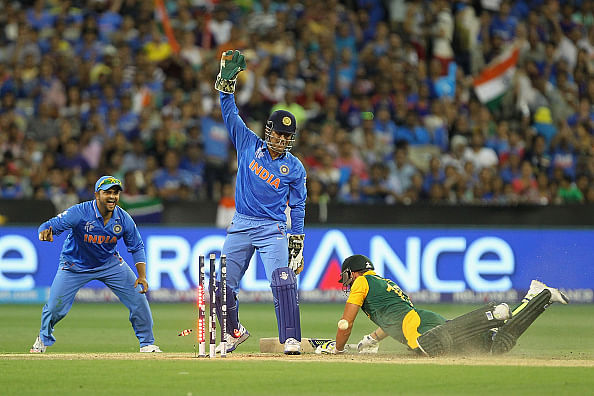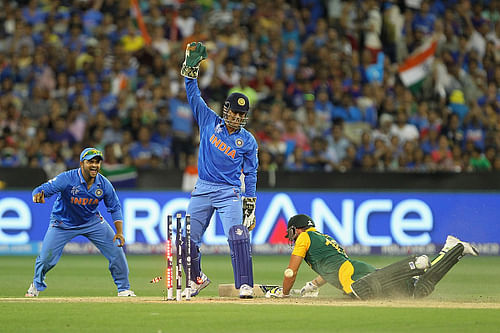
Chokers or not, South Africa are not the favourites at the World Cup

Any world tournament, regardless of the nature of the sport, is played in an intense, high-pressure environment. The stakes are unimaginably high and probably even higher for a side that has come agonizingly close to winning it more than once, only missing just, despite having been deemed worthy by most.
Much has been made of South Africa’s fragility to sustain the enormity of high-pressure knockout games in ICC tournaments and quite justifiably so. For a team of that quality to have never delivered in an all-or-nothing game at the World Cup reveals at least shades of the team’s character, if not paint the entire picture.
There could be a number of possible factors that add up to explain why South Africa fail to deliver when it matters the most and for all one may know, there may absolutely be no pattern to those results at all. But that’s not the scenario over-zealous internet enthusiasts prefer to entertain and hence several theories explaining their inability to deal with pressure are peddled rather conveniently.
Overuse of ‘Chokers’ tag
Most of it, safe to say, is a case of lazy analysis lacking in substance and reason. The ‘Chokers’ label, the usage of which is shockingly common in internet parlance, explains little about South Africa’s travails in the history of this tournament. Of all their eliminations at the World Cups since their re-admission to ICC events in 1992, on no more than two instances – in 1999 and 2011 – did they find themselves in a winning position only to throw it away.
Of those two times, the former was probably the case of nerves giving into the magnitude of the moment whereas the latter was simply a batting collapse of inexplicable proportions – something we so often see happen but fail to resist the temptation of connecting some dots to validate our fantasies when it comes to South Africa.
At all the other occasions, they’ve either been comprehensively outplayed by oppositions or have been hard done by some complicated set of mathematical formulae, although few tend to acknowledge they were anything but certain to beat England from that point anyway.
South Africa third strongest side in World Cup
An unconvincing victory by their standards over Zimbabwe and a humiliating defeat to India later, the doomsayers are suddenly back into action and South Africa’s problems at the ICC events have once again started being discussed at length. This particular narrative of choking has gained so much in strength over the years, nearly every defeat of the Proteas is instantly seen in that light.
Well, the arguments certainly do not warrant any serious debate but that is in no way to suggest South Africa are a flawless unit sans any obvious weaknesses. AB de Villiers’ men are nowhere near to being the perfect combination of players and are by no means the certain favourites to break the hoodoo come March 29th. In the quest to prove the choking hypothesis, people have failed to observe something that’d otherwise seem fairly obvious – that South Africa are NOT the strongest side in the tournament. They’re the third strongest at best. And their weaknesses are evident from a very rudimentary assessment of the squad.
Their strength lies in their bowling department and that has majorly been the case with almost every South African side of the past. Dale Steyn is easily the best in business and Vernon Philander and Morne Morkel team up with him to make for a highly formidable attack.
In Imran Tahir, South Africa have a spinner who has mastered the craft of googly like few in the game have and is an asset to any side in this format. The bowling unit ticks all boxes and means business with utmost ruthlessness and professionalism. That watching Dale Steyn bowl is one of the prettiest sights in Cricket doesn’t quite hurt either.
Problems in Proteas middle order
But the moment one turns attention towards South Africa’s batting strength, the problems surface. That Hashim Amla and skipper AB de Villiers have upped their game a country mile above anyone else’s in world cricket across formats and that their batting has such a high aesthetic appeal seemingly covers up the lack of depth in their firepower. It almost feels wrong to question the batting prowess of a side that has Amla and De Villiers playing in its top four. But one cannot ignore the fact, the batting around those two is not quite at the same level and that both Australia and New Zealand and perhaps India too boast of a better lineup.
Quinton De Kock, Faf Du Plessis, David Miller and JP Duminy complete the top six for South Africa. De Kock opens the batting with Amla and while he’s earned popularity having scored in bulk in patches, consistency has not been his strong suit in a short career so far.
When it just looked like Du Plessis had finally established himself as an ideal ODI number 3 after his exploits in the tri-series in Zimbabwe, things started going south and his stats have since been underwhelming even against the most pedestrian of oppositions. JP Duminy is one of the most experienced players in the current roster, one who has always been spoken very highly of but has hardly ever lived up to that hype.
David Miller hits the Cricket ball with a brute force to a devastating effect but in order to extract the best out of him, South Africa need to liberate him the way Australia do Glenn Maxwell. Should you be relying on Miller to construct an innings in the middle order, there’s something definitely wrong with the planning.
Australia and New Zealand are far more balanced units
Perhaps South Africa have never encountered this scenario where they are not at the luxury of choosing from an array of world class all-rounders. Well, there’s a reason Jacques Kallis was a once-in-a-generation cricketer. What makes the present Australian side the outright title favourites, apart from the home advantage, is the versatility brought on the table by the likes of Maxwell, Mitchell Marsh, Shane Watson and James Faulkner.
Co-hosts New Zealand are for a change not going in with too many bits and pieces cricketers and Corey Anderson is the only classic all-rounder in their first choice XI; but their batting unit is definitely a more deep as well as settled one than the Proteas’.
A mere no-nonsense, disciplined approach in bowling by the Indians was enough to expose South Africa’s lack of batting depth and that would certainly have not gone unnoticed by the rest of the contenders. The likes of Australia, New Zealand and England, with a far superior bowling attack compared to India’s, can easily put the Proteas in a spot of bother while chasing big.
Teams as top-heavy as the current South African one is, generally tend to struggle at some point in big tournaments. Now, this entire argument could be deemed null and void, almost reduced to a joke if each one of Steyn, Amla and De Villiers manage to produce the goods throughout the tournament but the point to note is that South Africa aren’t quite the invincible unit people usually perceive them to be at these tournaments. And should they falter in another eliminator, it could very well be due to the lack of right resources than to any of those theories you’re more than likely to hear about.